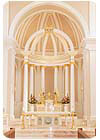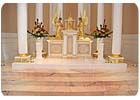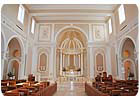
The Motherhouse - home to the Dominican Sisters of St. Cecilia Congregation - was initially built in 1860. Due to space constraints, a recent renovation and expansion project took place, which involved building a 15,000-square-foot chapel.
The Motherhouse - home to the Dominican Sisters of St. Cecilia Congregation - has stood as a prominent landmark in Nashville, TN, since 1860. While the structure was originally built to house a private girls' academy, today it is home to more than 200 Sisters. And with the congregation growing by almost 50% in the past 14 years, the Sisters were in dire need of more space. As a result, an approximate 115,000-square-foot addition, including a new chapel, was recently built. The chapel not only provides enough room for all the Sisters to gather and pray, but it is also a beautiful display of stone craftsmanship.
“It is really comprised of four separate buildings that were added to make 84,000 square feet,†said Project Architect Jim Thompson, AIA, of Fowlkes and Associates in Nashville. “The first one was built in 1860; the first addition in 1880; another addition in 1889; and another in 1904. All were built as a private girls' academy. When the school moved to new property in the western part of Nashville, they made this the Motherhouse and convent.

Blanco Tasos marble from Yugoslavia was chosen for the altars, base of the tabernacle and the ambo. Additionally, the floor of the sanctuary and apse features Rosa Aurora marble from Portugal.
“When we first came, we took a tour to immerse ourselves in their culture and see what it was like,†said Thompson. “We saw Sisters sleeping on mattresses between the bookshelves. They needed more space.â€
According to the architect, new girls enter the convent to be trained as Sisters. Nuns remain in the convent, while these Sisters are teachers and go out to a total of 36 missions across the country. But since the Motherhouse is their core, they do return from time to time. “There are 140 Sisters there year-round, and then others come home,†said Thompson. “In the previous chapel, they couldn't all sit there. They very much needed to have them all there to enhance the community. The new chapel can seat up to 350.â€

While the majority of the floor tiles were 12 x 12 inches, some 24- x 24-inch pieces were used in select areas. Slabs of Rosa Aurora were employed for the steps.
Designing the chapel
When the time came to design the new chapel, the Sisters hired a liturgical consultant, James McCrery of Frank, Lohsen, McCrery Architects of Washington, DC, to work with the design team. “He took our initial drawings and enhanced them,†said Thompson. “He then turned them back over to the Sisters for us to complete the construction drawings and to follow the construction.â€While the original Victorian buildings of the Motherhouse are comprised of brick and limestone, it was decided that the design of the new chapel should reflect the 5th century church, St. Sabina Church in Rome, which is based on the Roman Basilica plan. It is there that their patron saint, St. Dominic, lived in the adjacent monastery, according to Thompson. “For the interior of the chapel, we wanted to use the finest materials to honor the house of God,†he said.
Additionally, the Sisters also hired Granda Liturgical Arts of Madrid, Spain, to provide its expertise. Thompson explained that since this group specializes in projects such as this, they offered invaluable insight.
“They came up with the more decorative items,†said the architect. “The Sisters asked them about colors and materials. They were providing the more artistic aspects, so we wanted to hear their thoughts.â€

Detailing the front of the main altar is a mosaic that was crafted in Italy.
Stone selection
The group in Spain sent two marble samples to the Sisters. “We wanted something readily available in Nashville,†said Thompson. “We went to find matching material, and found marble from Portugal and Yugoslavia. We wanted a white stone for purity and have the altar on top of that. Pink was selected because it gives color, and it blends the whole interior well.â€In addition to the altars, Blanco Tasos marble from Yugoslavia was also used for the base of the tabernacle and the ambo. Detailing the front of the main altar is a mosaic that was crafted in Italy. The white base of the tabernacle is accented by Green onyx from Pakistan.
For the floor of the sanctuary and apse, Rosa Aurora marble from Portugal was chosen. The majority of the tiles were 12 x 12 inches, although some 24- x 24-inch pieces were used in select areas. Additionally, slabs of the material were employed for the steps.
“We chose Rosa Aurora and Blanco Tasos marble for these areas because the Sisters were drawn to the pinker flesh tones that helped to create a feminine interior, and white for the purity and nobility of the material due to its religious symbolism,†said Thompson. The architect explained that finding marble in both slab and tile forms that matched in color and veining posed a bit of a challenge.
“The Rosa Aurora tile was more similar [from] tile to tile, with very little veining,†he said. “The slab form used on the steps was more pronounced in its veins, with wider color variation. Luckily, we had a wonderful installer who worked with the design team to find a very pleasing solution.â€
Being a part of history
All those involved with the renovation and expansion of the Motherhouse took great care in its planning and construction. Added to the National Register of Historic Places in 1971, the institution is viewed as a historic treasure.“We all knew going into this project that it was the project of a lifetime and that the chapel was the heart of their organization, so we wanted to make sure that we did our best work,†said Thompson. “Everyone did - from the masons to the talented individuals that created the beautiful religious fixtures of the altar, altar of repose, baldachino, ambo, etc.â€
The architect went on to say that the design team was frequently on site during construction to help answer any questions and to tweak field issues as they came about. He also added that the Sisters living on site also offered tremendous assistance.

“We chose Rosa Aurora and Blanco Tasos marble for these areas because the Sisters were drawn to the pinker flesh tones that helped to create a feminine interior, and white for the purity and nobility of the material due to its religious symbolism,†said Project Architect Jim Thompson of Fowlkes and Associates in Nashville, TN.
The entire project started in the fall of 2001 and was completed in June of 2006 under three phases. The new chapel was dedicated right before Christmas last year.
“Very rarely do I get prideful in my projects, but this is one that turned out so beautiful,†said Thompson. “Everyone I know who has visited the Motherhouse has walked away taken with the Sisters and their generosity. Although the Motherhouse grew from 84,000 square feet to nearly 200,000 square feet, everyone is very complimentary of the sense of 'home' that was maintained throughout. At the end of my life, I know that this will be the highlight of my career - what a wonderful feeling to know that your work will affect so many people long after you are gone.â€
The Motherhouse Chapel
Nashville, TN
Lead Architect: Fowlkes and Associates, Nashville, TN
Liturgical Consultant / Design Architect: Frank, Lohsen, McCrery Architects, Washington, DC
Interior Designer: Paula Harris
Interior Consultant: Granda Liturgical Arts, Madrid, Spain
General Contractor: Hardaway Construction Corp., Nashville, TN
Stone Installer: Southern Ceramics
